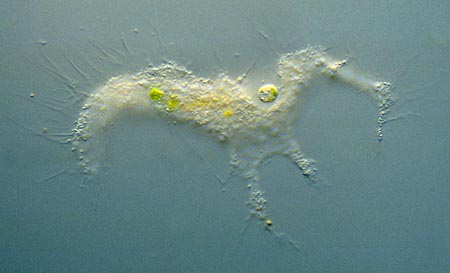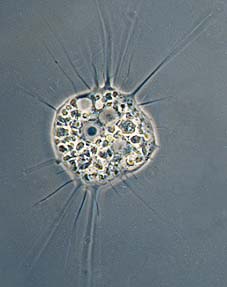STUDYING TINY AMOEBA
by Wim van Egmond, The Netherlands

Probably Vampyrella (Not because it resembles a bat :-) although I am not sure. This image shows that some amoeba have filamentous pseudopods.
|
STUDYING TINY AMOEBA by Wim van Egmond, The Netherlands |

Probably Vampyrella (Not because it resembles a bat :-) although I am not sure. This image shows that some amoeba have filamentous pseudopods. |
|
| The first two pages of this article only mention the bigger species. Most amoeba are much smaller. Most don't exceed one tenth of a millimetre (100 micron) and the smallest are even less than 10 micron. Studying these is even more complicated than for the big amoeba. |
 |
A
great method to study tiny protozoans
I recently found a good way to catch and observe these tiny amoeba. A method that also works for other small protozoa. You need a good sample of water from a pond. Squeezing water-plants (like pond scum) is always a good method to concentrate microorganisms. Don't forget to take some water-plants with it. Than put the water in a shallow dish. It is always best to keep it shallow so the water can absorb enough oxygen. The trick is to place a cover-slip on the water surface. Drop it gently so it will float. Use several coverslips. If you let the cover-slips float for a day (or night) bacteria will grow on the underside of the coverslip. All kinds of small protozoa will feed on these bacteria. The top of the coverslip will remain clean and dry. Take out the coverslip very carefully. a pair of forceps may be a good aid. Wipe the topside a bit just to be sure and place it on a slide. It is good to add a small drop of water to the slide to prevent airbubbles. I use a very small brush to lower the coverslip on the slide. (Steve Durr showed me that!) You can examine this with the 40X or more. The use of immersion oil is easier than with a normal slide. The advantage is that you don't get so much dirt (detritus) in your slide since this remains on the bottom of the dish. With this method you will only get living stuff, not the dirt. |
|||
| Amoeba
taxonomy
Amoeba were given their own Phylum, Rhizopoda, meaning : 'root footed'. In this article I only describe the most common fresh water groups. (Not the parasitic amoeba that cause illness: amoebic dysentery). The last page focusses on another important group, the shelled amoebas. |
|
Page 1: Amoebas are more than just blobs
|
|
|
All comments to the author Wim van Egmond are welcomed.
Find
out more about microscopic pond life on The
Smallest Page on the web
The
Pond Life Identification Kit may help
you identifying small freshwater organisms
Visit Wims home page for links to his many web pages on microscopy
Please report any Web problems or
offer general comments to the Micscape
Editor,
via the contact on current Micscape
Index.
Micscape is the on-line monthly magazine
of the Microscopy UK web
site at Microscopy-UK